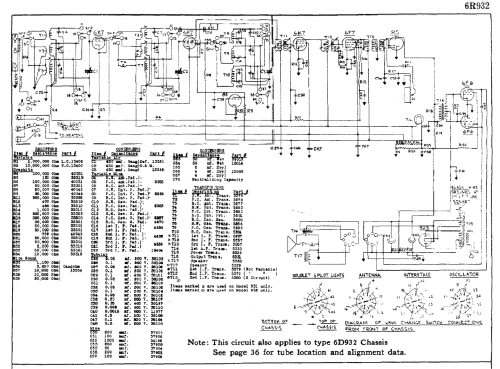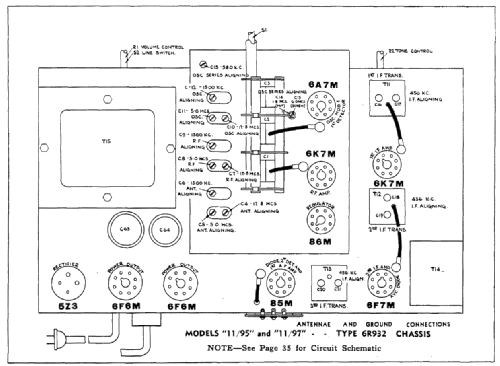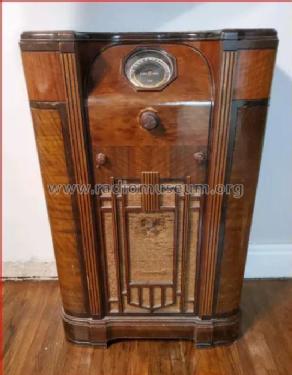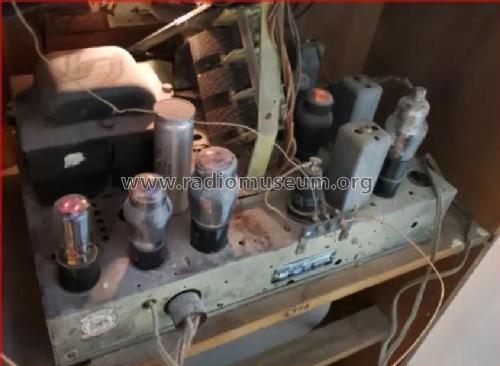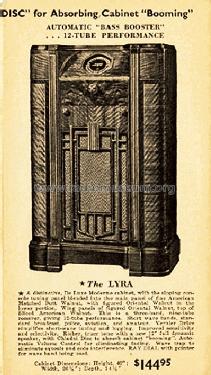Lyra (with Chladny Disc) Lyre Ch= 6D932
De Forest (DeForest) Crosley Radio, Consolidated Industries; Toronto
- País
- Canada
- Fabricante / Marca
- De Forest (DeForest) Crosley Radio, Consolidated Industries; Toronto
- Año
- 1936/1937

- Categoría
- Radio - o Sintonizador pasado WW2
- Radiomuseum.org ID
- 158510
Haga clic en la miniatura esquemática para solicitarlo como documento gratuito.
- Numero de valvulas
- 9
- Principio principal
- Superheterodino con paso previo de RF; ZF/IF 456 kHz; 2 Etapas de AF
- Número de circuitos sintonía
- 10 Circuíto(s) AM
- Gama de ondas
- OM, OC y banda Pesquera (policia USA)
- Tensión de funcionamiento
- Red: Corriente alterna (CA, Inglés = AC)
- Altavoz
- Altavoz electrodinámico (bobina de campo)
- Material
- Madera
- de Radiomuseum.org
- Modelo: Lyra Lyre Ch= 6D932 - De Forest DeForest Crosley
- Forma
- Consola en general
- Ancho, altura, profundidad
- 26.5 x 40 x 14.25 inch / 673 x 1016 x 362 mm
- Anotaciones
-
The schematic labels the 85M as the voltage regulator while the tube layout has the 86M there. I believe the schematic is mislabeled and has the two tubes switched. A push-pull audio output circuit and an automatic bass booster is used in this model Lyra 6D932. The Rogers 11-95, 11-97, Majestic Resolution and Bonaventure are electronically identical to this set.
The DeForest Crosley console radio model Neptune wich chassis 6D731 and Lyra 6D932 show a "Chladni Disc for absorbing cabinet booming" (Chladni plate). This is a gadget for visualization of vibration patterns, by spreading a uniform layer of sand on a disk, and observing displacement when vibration is applied. It can be done with a loudspeaker. From Wikipedia (Feb 2012): "Ernest Florens Friedrich Chladni, born 1756 in Wittenberg (died 1837 in Breslau) was a Slowaky physicist, musician and astronome, living in Germany. One of Chladni's best-known achievements was inventing a technique to show the various modes of vibration on a mechanical surface. Chladni repeated the pioneering experiments of Robert Hooke of Oxford University who, on July 8, 1680, had observed the nodal patterns associated with the vibrations of glass plates. Hooke ran a bow along the edge of a plate covered with flour, and saw the nodal patterns emerge. Chladni's technique, first published in 1787 in his book, Entdeckungen über die Theorie des Klanges ("Discoveries in the Theory of Sound"), consisted of drawing a bow over a piece of metal whose surface was lightly covered with sand. The plate was bowed until it reached resonance and the sand formed a pattern showing the nodal regions. Since the 20th century it has become more common to place a loudspeaker driven by an electronic signal generator over or under the plate to achieve a more accurate adjustable frequency. Variations of this technique are commonly used in the design and construction of acoustic instruments such as violins, guitars, and cellos." There is a folder "Nuveaux Modèles de Luxe 1937" with le Neptune, le Lyre, le Comète, le Jupiter, l'Étoile Royale with door, which means season 1936/37.
- Precio durante el primer año
- 144.95 $
- Referencia esquema
- Radio College of Canada
- Mencionado en
- RCC Rogers-Majestic section page 19
- Autor
- Modelo creado por Robin Roeckers. Ver en "Modificar Ficha" los participantes posteriores.
- Otros modelos
-
Donde encontrará 272 modelos, 131 con imágenes y 183 con esquemas.
Ir al listado general de De Forest (DeForest) Crosley Radio, Consolidated Industries; Toronto
